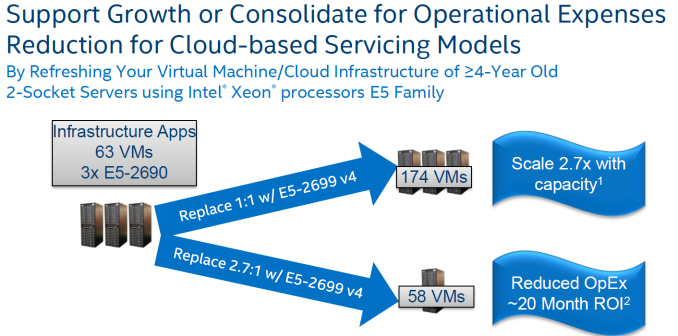The Intel Xeon E5 v4 Review: Testing Broadwell-EP With Demanding Server Workloads
by Johan De Gelas on March 31, 2016 12:30 PM EST- Posted in
- CPUs
- Intel
- Xeon
- Enterprise
- Enterprise CPUs
- Broadwell
Closing Thoughts
With the limited amount of time we had to spend with the new Broadwell-EP Xeons ahead of today's embargo, we spent most of our time on our new benchmarks. However we did a quick check on power as well. It looks like both idle power and load power when running a full floating point workload have decreased a little bit, but we need to do a more extensive check to further confirm and characterize this.
Meanwhile, considering what a wonderful offering the Xeon E5-2650L v3 was, it is a pitty that Intel did not include such a low power SKU among our samples for review. The Xeon E5-2699 v4 is a solid product, but it's not a home run. Either this is just an hiccup of our current setup (firmware?), but it seems the new Xeon E3 v4s do not reach the same turbo speeds as our Xeon E5 v3s. As a result, single threaded performance is (sometimes) slightly slower, and the new processor needs more cores to beat the previous one.
We noticed this mostly in the HPC applications, where the new Xeon is a bit of mixed bag. Still, considering that 72 to 88 threads are a bit much for lots of interesting applications (Spark, SQL databases...) there is definitely room for processors that sacrifice high core counts for higher single threaded performance (without exagerating). We have been stuck at 3.6 GHz for way too long.
With that said, there is little doubt that the Xeon E5-2699 v4 delivers in the one application that matter the most: virtualization.
Although we have not yet extensively tested on top of an hypervisor, we are pretty sure that the extra cores and the lower VMexit latencies will make this CPU perform well in virtualized environments. Intel's resource director technology and many improvements (posted interrupts) that help the hypervisor to perform better in I/O intensive tasks are very attractive features.
Although it is not much, as compared to the Haswell-EP based Xeon E5 v3s, performance has also increased by about 20% in key applications such as databases and ERP applications. And while we can complain all we want about the slightly regression in single threaded performance in some cases, the fact of the matter is that Intel has increased performance by 2 to 2.7 times in four years in those key applications, all the while holding power consumption at more or less the same. In other words, it will pay off to upgrade those Sandy Bridge-EP servers. And for many enterprises, that is what matters.











112 Comments
View All Comments
petar_b - Saturday, August 27, 2016 - link
Thanks Phil_Oracle, Brutalizer and Anand for this discussion. I have learned a lot from reading different opinions. I am working with IBM and Oracle software products, and from my small experience, Xeons are pathetic when compared to POWER or SPARC. To do same operation at home Xeon it takes 10x more time than what it takes the corporate server to do. I have double memory than corporate server and yet no help from it.someonesomewherelse - Thursday, September 1, 2016 - link
Btw how locked down are these Xeons and their motherboards in regards to overclocking? Assuming you could provide enough power and cooling could you reach a decent overclock? Obviously nobody is going to do that for mission crittical servers/workstations, but if I had too much money could I get a quad or octa core system with as much cores possible and at least try to overclock them?